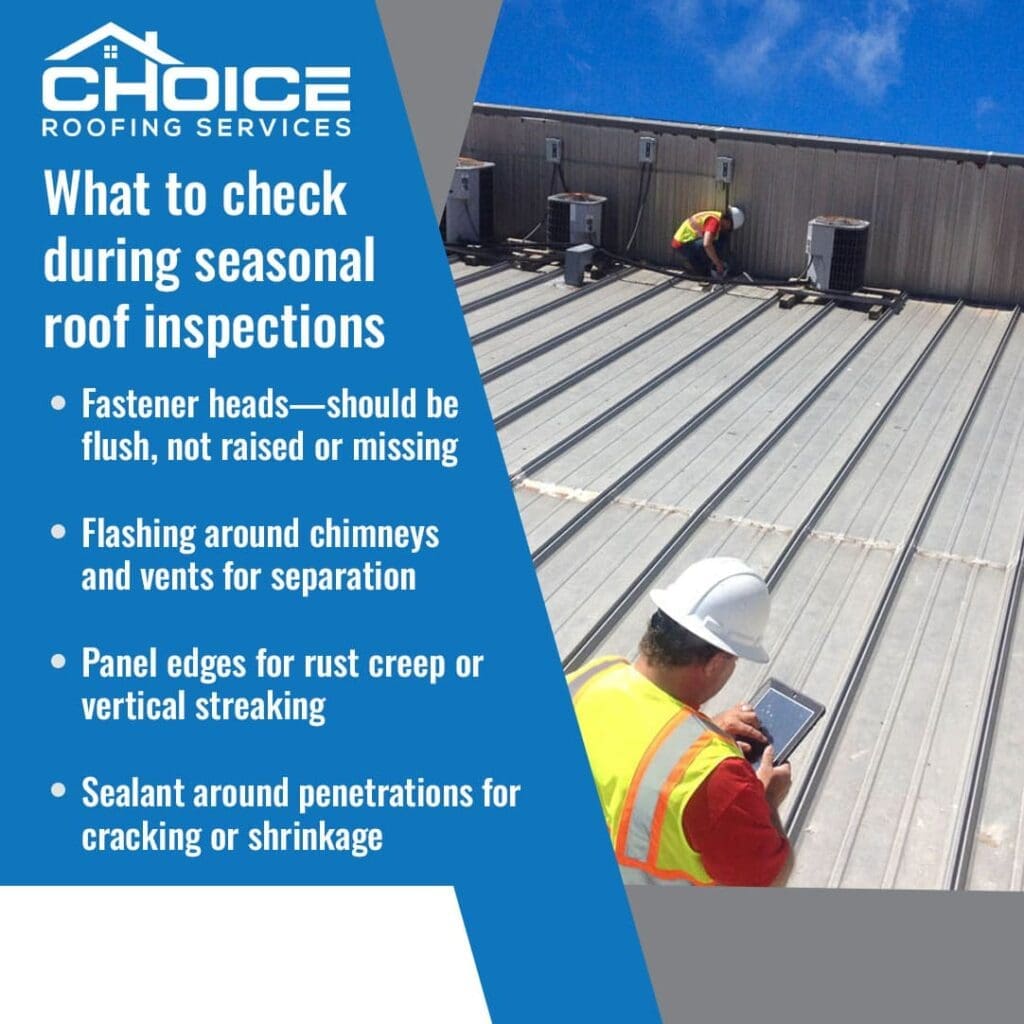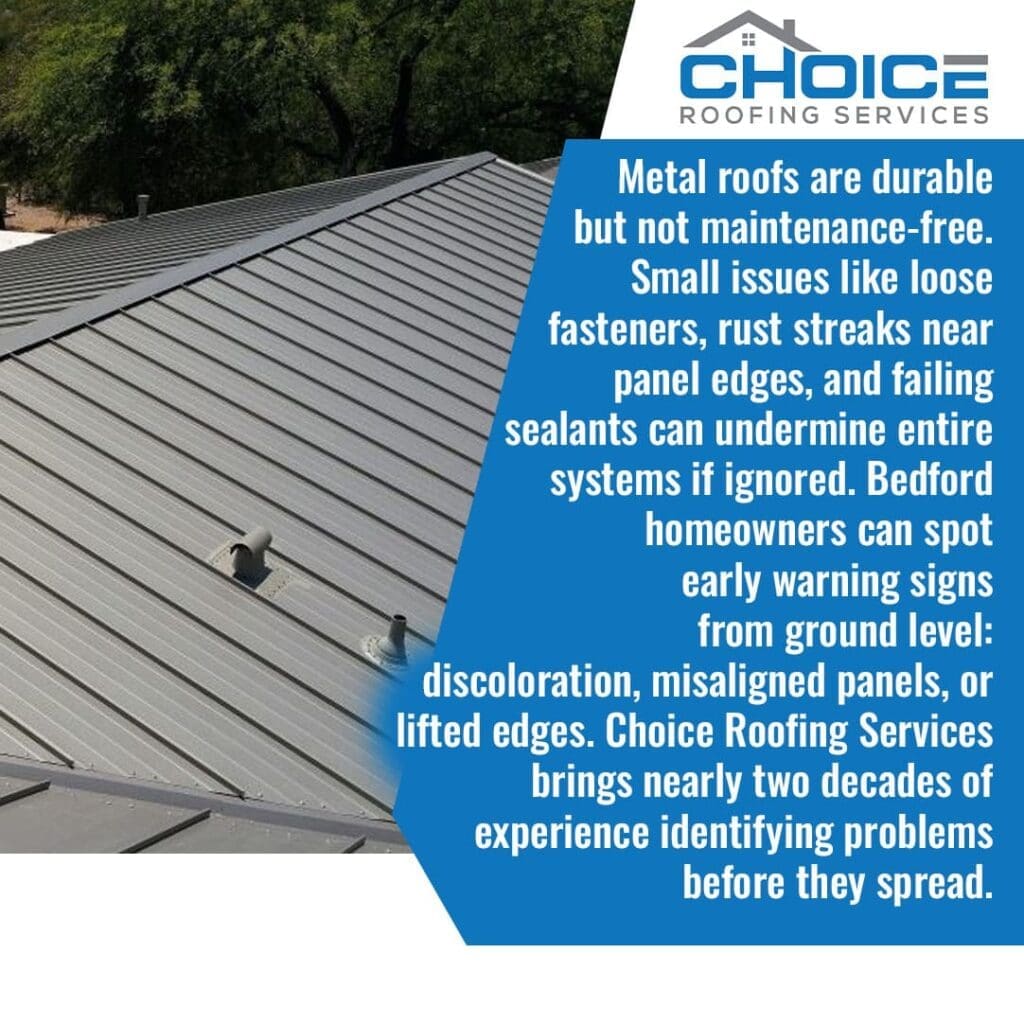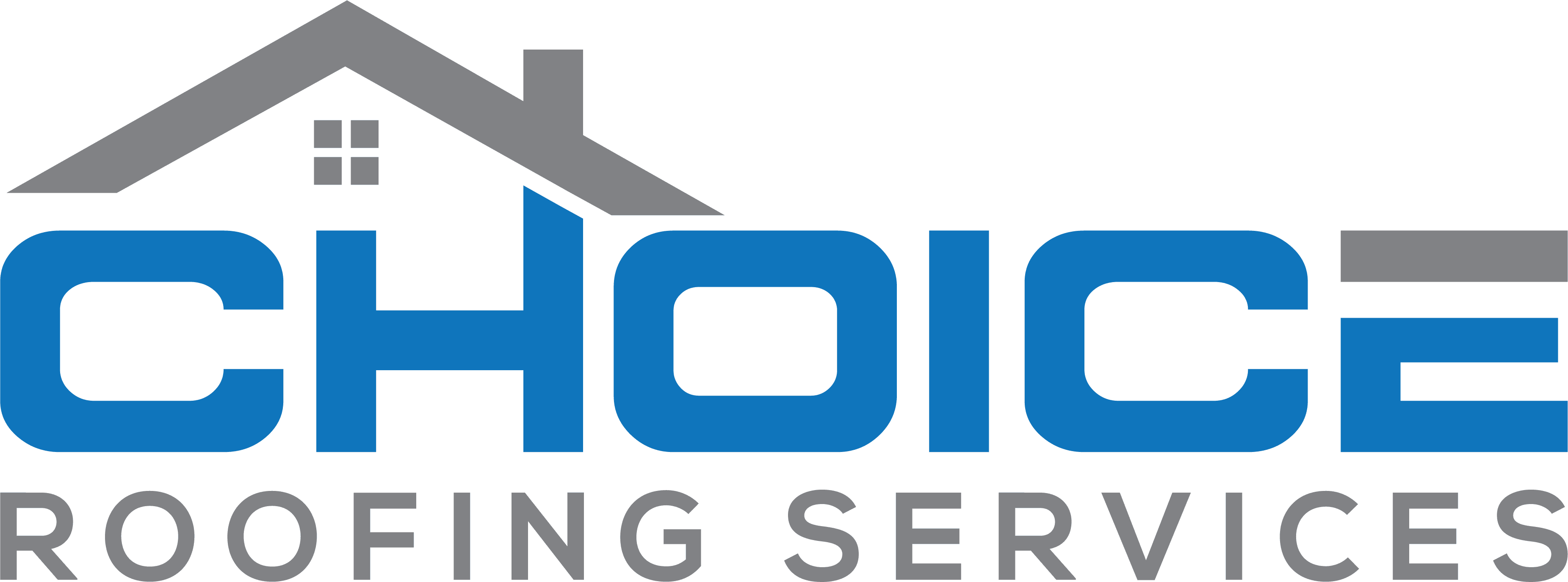Inspect your metal roof twice yearly for loose fasteners, small rust spots, and seal deterioration. Early detection transforms simple fixes into prevention against extensive damage requiring major work. Metal roofing systems deliver decades of reliable performance, but their longevity depends on catching small problems before they escalate. Understanding what to look for and when to act separates property owners who enjoy trouble-free roofs from those facing emergency repairs and significant expenses down the road.
At Choice Roofing Services, LLC, we have spent 18+ years helping property owners in Bedford County and the surrounding areas protect their metal roofing investments. Most extensive roof repairs we encounter started as minor issues that could have been resolved quickly and affordably. This guide provides the knowledge needed to spot these problems early and take appropriate action.
Where Metal Roofs Develop Problems First
Metal roofing systems consist of interconnected components working together to create weatherproof protection. Each connection point, fastener location, and transition area represents a potential weak spot requiring periodic inspection.
Temperature fluctuations cause metal panels to expand and contract throughout each season. This natural movement gradually affects fasteners, sealants, and panel connections. Pennsylvania’s climate places additional stress on these vulnerable points.
Identifying problem areas before they fail prevents the chain reaction that transforms minor issues into major damage. Water infiltration through one compromised fastener can spread to adjacent areas, damaging underlying decking and creating interior leaks that affect multiple building systems.
Visual Inspection Techniques Homeowners Can Use
Ground-level visual inspections provide valuable information about roof condition without safety risks. Using binoculars from various vantage points around your property allows examination of different roof sections and identification of obvious problems. Look for these warning signs during visual inspection:
Surface Discoloration and Rust Formation
Discoloration indicates potential rust formation or coating failure developing beneath the surface. Small brown or orange spots near fasteners or along panel edges signal corrosion beginning beneath protective finishes. Dark streaks running down panels suggest water traveling from compromised areas above. These visual cues help identify problems before they penetrate through the metal substrate.
Panel Misalignment and Waviness
Misalignment becomes visible as gaps between adjacent sections or raised edges that don’t lie flat against the roof surface. Temperature changes cause these alignment issues to worsen over time as thermal expansion stresses panel connections. Waviness across panel surfaces points to installation problems or structural movement requiring professional assessment. Even slight variations from a flat, uniform appearance warrant closer examination.
Debris Accumulation in Valleys and Penetrations
Debris accumulation in roof valleys or around penetrations traps moisture against metal surfaces for extended periods. Leaves, branches, and granular material hold water in contact with protective coatings, accelerating deterioration through constant exposure. Regular visual checks help identify cleaning needs before organic material causes damage or creates conditions for rust development.
Conduct these visual inspections during spring and fall when moderate temperatures make outdoor assessment comfortable. Additional checks after severe weather help identify storm damage requiring prompt attention from a roof repair company.

Recognizing Fastener Problems Early
Fasteners secure metal panels to roof decking and represent the most common repair need on metal roofing systems. Temperature cycling, wind forces, and improper initial installation contribute to fastener failures over time. Signs of developing fastener issues include:
Raised or Elevated Fastener Heads
Exposed fastener heads sitting higher than surrounding panels indicate loosening from thermal expansion. Metal panels move slightly with temperature changes, and this movement works fasteners loose over months and years. A fastener that’s slightly raised today can pull completely free during the next storm.
Rust Rings and Water Stains
Rust rings around fastener locations show moisture penetrating protective seals. Rubber washers deteriorate with UV exposure and age, allowing water to pass through fasteners into the roof decking. Small water stains on interior ceilings often trace back to failed fastener seals on the exterior.
Missing Fasteners and Open Holes
Missing fasteners create obvious holes that require immediate attention. Wind forces during storms can pull loose fasteners completely free, leaving openings for water infiltration. Standing water around these holes damages the surrounding areas and spreads to adjacent roof sections.
Irregular Fastener Patterns
Check fastener lines from ground level using binoculars. Straight, uniform rows indicate proper installation and maintenance. Irregular spacing or missing units in otherwise straight lines signal developing problems requiring assessment from experienced roof repair contractors.
Professional roof repair services possess specialized tools for properly tightening loose fasteners without over-compression that damages washers. They also match fastener types and finishes to existing installations, maintaining both function and appearance.
Surface Corrosion and Rust Detection
Modern metal roofing includes protective coatings designed to prevent corrosion for decades. However, scratches from falling branches, abrasion from walking traffic, or manufacturing defects create vulnerable spots where rust begins. Early-stage rust appears as:
Edge Discoloration and Edge Creep: Panel edges naturally show light discoloration where the protective coating stops. This normal oxidation rarely requires action unless it begins spreading across the panel surface.
Vertical Streaking Patterns: Rain carries rust particles from corroded areas down across lower panels, creating visible streaks. These stains reveal active corrosion that requires finding and treating the source.
Extensive corrosion demands professional roof repair services. Coastal properties and buildings near industrial areas face accelerated corrosion from salt spray and airborne chemicals. Annual inspections become even more important in these environments where protective coatings deteriorate faster than in typical inland locations.
Flashing and Sealant Condition Assessment
Flashing systems direct water away from vulnerable roof transitions, including valleys, penetrations, and wall intersections. These components experience more movement than the main roof panels, making them prone to earlier failure. Inspect flashing areas for:
- Gaps Between Flashing and Surfaces – Sealants shrink with age and temperature cycles, creating openings where water enters. Even small separations allow moisture infiltration during wind-driven rain. These gaps often appear first at corners and transition points.
- Cracked or Dried Sealant – UV exposure degrades sealants around chimneys, skylights, and vent pipes over several years. This reduces their flexibility and adhesion. Brittleness indicates approaching failure even before visible gaps appear.
- Lifted or Loose Flashing Edges – Wind forces and temperature changes cause flashing to gradually separate from its attachment points. Unsecured edges catch wind and bend, creating permanent damage. These situations require replacement rather than simple resealing.
Professional assessment determines whether existing flashing requires resealing or complete replacement. Proper flashing repair includes surface preparation, appropriate sealant selection, and installation techniques that accommodate ongoing thermal movement. These specialized skills explain why flashing repairs benefit from experienced roof repair contractors rather than DIY attempts.
Panel Seam and Alignment Problems
Standing seam metal roofing relies on precise panel connections to maintain weatherproof integrity. Exposed fastener systems depend on proper panel overlap and secure attachment. Both configurations develop problems when connections fail.
Separated Standing Seam Connections
Separation along standing seam connections where panels no longer interlock completely. Temperature extremes and wind forces stress these connections over time. Small gaps at seam tops allow water entry during heavy rain.
Visible Gaps in Panel Overlaps
Visible daylight through panel overlaps on exposed fastener roofs indicates installation problems. Proper installation creates sealed overlaps, preventing water infiltration. Gaps indicate improper initial installation or panel movement from structural settling.
Wavy or Rippled Panel Surfaces
Wavy or rippled panels suggest improper fastening or inadequate thermal expansion accommodation. Metal needs room to move with temperature changes. Installations that don’t allow this movement create visible distortion and internal stresses that accelerate other failures.
Panel alignment problems rarely improve independently and require professional attention from a roof repair company. Early detection and correction prevent progressive damage to adjacent areas. What begins as one problem seam can affect surrounding panels through stress transfer and water infiltration.
Interior Warning Signs Indicating Exterior Problems
Metal roof issues don’t always announce themselves from the outside. Damage often becomes visible inside your home first, especially when problems develop in areas hidden from ground-level view. Recognizing these indoor indicators prevents delayed action based on a roof that appears fine from the curb. Warning signs visible from inside include:
Water Stains on Ceilings and Walls
Water stains signal active leaks requiring immediate attention. Brown or yellow discoloration indicates moisture penetration over time. Even small stains suggest ongoing issues that worsen during each rain event. These marks often appear before any exterior damage becomes visible during ground-level inspection.
Attic Moisture or Frost Formation
Moisture or frost in attic spaces points to ventilation issues or active leaks hidden beneath the roofline. Metal roofing systems require proper attic ventilation to prevent condensation. Excessive moisture damages insulation and wooden structure components long before exterior signs develop.
Temperature Fluctuations in Upper Floors
Unusual temperature variations in upper-floor rooms indicate compromised insulation or air infiltration through damaged areas invisible from outside. Sudden increases in heating or cooling bills often provide the first clue of roof problems. Addressing these issues improves both protection and energy efficiency throughout your home.
Musty Odors in Upper-Level Spaces
Musty smells suggest hidden moisture from roof leaks that haven’t yet created visible ceiling stains. Mold growth occurs quickly in damp environments, creating health concerns and structural damage requiring immediate professional assessment. These odors warrant roof inspection even when the exterior appears intact.
Roof repair and replacement costs totaled nearly $31 billion last year, marking a 30% increase since 2022. Many of these expenses could have been reduced through earlier detection and intervention when interior warning signs first appeared. Contacting experienced contractors for roof repair near you at the first sign of interior damage prevents small problems from becoming expensive emergencies.

Professional Inspection Timing and Value
While homeowners can identify some problems through careful observation, professional roof inspection provides a thorough assessment impossible from ground level. A qualified roof repair company spots subtle issues that untrained eyes miss. Professional inspections offer:
Safe Access Without Injury Risk: Walking on metal roofs requires proper equipment and technique to avoid panel damage. Professionals carry appropriate insurance and safety gear for secure roof access.
Knowledge of Local Failure Patterns: Professionals know the specific failure patterns based on roof age, installation method, and local climate factors. Bedford County’s weather patterns create predictable stress points that experienced contractors recognize immediately.
Specialized Detection Tools: Specialized tools are needed for testing sealant adhesion, measuring panel alignment, and identifying hidden damage. Moisture meters detect problems before interior stains appear. Thermal imaging reveals insulation gaps and air infiltration paths.
Written Documentation and Reports: Written documentation of roof condition is useful for warranty claims and property sale disclosure. Professional inspection reports provide objective condition assessment and recommended maintenance priorities.
Schedule professional inspections every 2-3 years for roofs under 15 years old. Increase frequency of annual assessments for older systems or following severe weather events. This preventive approach maintains roof performance while protecting interior spaces from water damage.
When searching for professional roof repair near you, prioritize contractors with local experience and metal roofing expertise. Our team at Choice Roofing Services has served the Bedford area for nearly two decades. We understand local conditions affecting metal roofing performance and provide thorough assessments identifying all current and developing problems.
When to Contact a Roof Repair Company
Understanding the difference between problems requiring immediate professional attention and issues suitable for monitoring helps property owners make appropriate decisions. Some situations demand a rapid response, while others allow a scheduled assessment during routine inspection.
Call roof repair contractors immediately for:
- Active water infiltration: Leaks cause progressive damage that worsens hourly during precipitation events. Emergency response prevents additional harm to interior finishes, furnishings, and electrical systems.
- Multiple loose or missing fasteners: These represent imminent failure risks during the next significant weather event. Prompt attention prevents panel loss and associated damage.
- Large rust areas or obvious panel damage after storms: Waiting allows water infiltration that damages materials beyond visible problems. Quick response limits repair scope and complexity.
Schedule routine professional assessment for:
- Minor surface rust in isolated locations: These respond well to treatment but don’t represent immediate failure risks. Professional application of proper materials during scheduled visits provides lasting protection.
- Gradual sealant deterioration around flashing without active leaks: Resealing during planned maintenance prevents future problems while maintaining your roof’s weatherproof integrity.
General roof condition verification for properties over 15 years old. Systematic assessment identifies developing issues before they require urgent attention. Planned maintenance always proves more manageable than emergency response.
Trust Choice Roofing Services for Expert Metal Roof Care
Metal roofing systems deliver exceptional value through decades of reliable performance when properly maintained. Small investments in regular inspection and prompt attention to minor issues multiply return on your roofing investment through extended service life and prevention of extensive emergency repairs.
Choice Roofing Services brings specialized metal roofing expertise to every inspection and repair service. Our 18+ years of serving Bedford, Altoona, Johnstown, Somerset, and McConnellsburg have taught us exactly what to look for and how to address problems before they escalate.
We combine thorough assessment with honest recommendations. When we find minor issues, we explain what they mean, how they might progress, and what corrective action makes sense for your situation and budget.
Our reputation throughout Bedford County reflects our commitment to quality workmanship and customer satisfaction. We approach every roof repair near you with the same attention to detail that has built our business through customer referrals and repeat service relationships.
Schedule Your Professional Metal Roof Inspection Today
Contact Choice Roofing Services at (814) 410-1409 or email daniel.choiceroofing@gmail.com to schedule your professional metal roof inspection. We’ll identify current conditions, explain what we find, and provide clear recommendations for keeping your roof performing properly for years to come. Protect your property with expertise you can trust.

